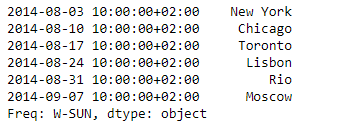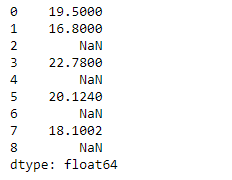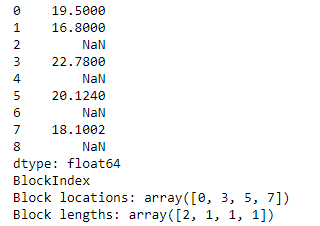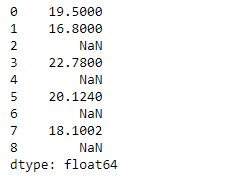Python Pandas Series.to_csv()
Pandas系列是一个带有轴标签的一维ndarray。标签不需要是唯一的,但必须是一个可散列的类型。该对象支持基于整数和标签的索引,并提供了大量的方法来执行涉及索引的操作。
Pandas Series.to_csv()函数将给定的系列对象写入一个逗号分隔的数值(csv)文件/格式。
语法: Series.to_csv(*args, **kwargs)
参数:
path_or_buf :文件路径或对象,如果没有提供,结果将作为一个字符串返回。
sep :长度为1的字符串。 输出文件的字段分隔符。
na_rep :缺失的数据表示。
float_format :浮点数的格式字符串。
column:要写的列
header : 如果给了一个字符串列表,它被认为是列名的别名。
index :写入行名(索引)。
index_label : 如果需要,索引列的标签。如果给定的是None,并且header和index都是True,那么就会使用索引名称。
mode : Python写模式,默认为’w’。
encoding : 代表输出文件中使用的编码的字符串。
zip:压缩模式在以下可能的值中。{‘infer’, ‘gzip’, ‘bz2’, ‘zip’, ‘xz’, None}.
quotechar :长度为1的字符串。 用于引用字段的字符。
返回:无或str
示例#1:使用Series.to_csv()函数将给定的系列对象转换为csv格式。
# importing pandas as pd
import pandas as pd
# Creating the Series
sr = pd.Series(['New York', 'Chicago', 'Toronto', 'Lisbon', 'Rio', 'Moscow'])
# Create the Datetime Index
didx = pd.DatetimeIndex(start ='2014-08-01 10:00', freq ='W',
periods = 6, tz = 'Europe / Berlin')
# set the index
sr.index = didx
# Print the series
print(sr)
输出 :

现在我们将使用Series.to_csv()函数将给定的Series对象转换成逗号分隔格式。
# convert to comma-separated
sr.to_csv()
输出 :

正如我们在输出中看到的,Series.to_csv()函数已经将给定的Series对象转换为逗号分隔的格式。
示例#2:使用Series.to_csv()函数将给定的系列对象转换为csv格式。
# importing pandas as pd
import pandas as pd
# Creating the Series
sr = pd.Series([19.5, 16.8, None, 22.78, None, 20.124, None, 18.1002, None])
# Print the series
print(sr)
输出 :

现在我们将使用Series.to_csv()函数将给定的Series对象转换成逗号分隔格式。
# convert to comma-separated
sr.to_csv()
输出 :

正如我们在输出中看到的,Series.to_csv()函数已经将给定的Series对象转换为逗号分隔的格式。
 极客教程
极客教程